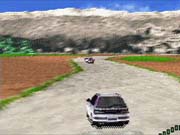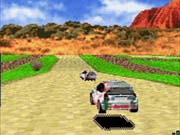Last year's GT Advance for the Game Boy Advance was a well-executed driving game that was best likened to a portable version of Gran Turismo. It had it all: intuitive controls, licensed cars, plenty of tracks, upgradable performance parts...and the most frustrating password save-system ever used on Nintendo's handheld. GT Advance was a great game, but the American release was hamstrung by the lack of a battery save. Thankfully, GT Advance 2: Rally Racing suffers from no such handicap. This sequel includes a battery that removes the tedium from the act of saving and loading your progress and leaves you to enjoy the game's simple yet addictive style of racing.

As you can probably deduce from the game's name, street racing isn't the focus of GT Advance 2, as it was in its predecessor. GT Advance 2 is strictly a rally racing game, and as such, it features tracks and cars that you'd expect to see in the real-life motor sport. The game has 15 licensed cars from recognizable manufacturers like Subaru, Mitsubishi, Suzuki, and Nissan, and each has different performance characteristics for acceleration, handling, grip, and maximum speed. These variances in performance do translate well in the actual game, and you'll easily be able to tell the difference between, say, a Mazda 323 and a Subaru WRX STi. Of course, all the best cars are locked away initially, so you'll have to make do with a slightly underpowered selection of vehicles at first. While you can't enhance any of these cars' performance through aftermarket upgrades like you could in the original game, GT Advance 2 does give you the option to set your car's existing suspension stiffness, steering speed, gear ratio, and brake balance setup to your liking at any time.
Like most racing games, GT Advance 2 has several modes of play, the most important of which is the career mode, which is called "world rally." Here, you'll compete in the same 14 events that real-life rally drivers participate in on a yearly basis. From Sweden to Cyprus, all of the major rally locations are well represented in the game. Each of these events is composed of three individual races, or legs, that require you to finish ahead of a certain number of cars before you're allowed to move on. Unlike in the real sport, you'll be racing directly against other drivers, and not against the clock. The rest of the field is staggered a good distance ahead of your car, so you'll essentially be playing a game of catch-up throughout GT Advance 2. While this might not be true to the sport of rally racing, it's obviously an attempt to keep the game fun and interesting, as a GBA racing game without any type of head-to-head competition would have been very bland.
And certainly, GT Advance 2 is anything but bland. The game will let you race against a friend on any track you've unlocked in the world rally mode, though like with the original GT Advance, two game cartridges are required. It has a considerable number of additional single-player modes--even for a racing game--that include a time trial mode, a single race option, a practice session, 15 different license tests that are designed to familiarize you with the mechanics of driving a rally car, and a unique option that lets you assume the role of the navigator. In this mode, you won't actually do any of the driving. Instead, it's your responsibility to call out the direction and severity of incoming turns to your driver. You can study a map of the track before the start of the race, and once you're off and running, you'll have only a small window of time within which to give the proper directions to your driver by pressing a series of button and D-pad combinations. If you fail to do so in time, or you give your driver wrong information, you'll both end up hitting a curb or spinning out. It's not an easy task, especially considering that you'll have to navigate largely by heart, but it's definitely a unique approach to rally racing games, and it makes for a nice bonus.
While this mode has been added to make the game accessible to as wide a range of people as possible, GT Advance 2 does retain a few important elements of realism. All of the tracks are made up of either tarmac, gravel, mud, or snow surfaces (or a combination of all four), as most rally events in real life are, and you'll be forced to change your tires before the start of every leg in order to account for these variances in terrain. Faster tires have poor traction in adverse conditions, while all-terrain tires will limit your speed on tarmac and straightaways. Choosing the right tire before every race is an integral part of rally racing, and often, some compromises have to be made. GT Advance 2 does a good job of illustrating this process.
When you compare GT Advance 2 to the original game from last year, you'll note that the graphics have received a slight shot in the arm. The tracks, for instance, are now peppered with peripheral objects like shrubbery and trees. Additionally, the scaling effect from GT Advance has been enhanced somewhat in this game to account for rally racing's rough terrain. The end result is tracks with bumps, dips, and slight elevation changes. In fact, you'll often find yourself catching air after hitting an unexpected hump on the road. If you never played the first game, you'll probably feel that the distance of the horizon is a little too close for comfort and that you won't have a lot of time to prepare for oncoming turns, but it only takes a few minutes to get used to this. In fact, after a while, you'll come to appreciate the game's smooth sense of speed. What hasn't changed since the original is the detail found in the cars, all drawn with numerous sprites instead of a small number of 3D polygons like the skaters in the Tony Hawk series of GBA games. No matter--the vehicles in the game look just like their real-world counterparts, and they're depicted using enough frames of animation to keep the turning from getting choppy.

The sound in GT Advance 2 isn't as impressive as it was one year ago in GT Advance. The sound effects are still good, but the variances between each car's engine sound, for example, is more subtle here than it was in the game's predecessor. GT Advance 2 does retain the same style of catchy yet simple music tracks that play in the game's menus and during the actual races. Additionally, some sounds will be abruptly cut off if there are too many effects playing at once. This is probably due to the GBA's limited sound channels, and it doesn't happen too often, but it is a noticeable distraction when it occurs.
GT Advance 2: Rally Racing is a worthy successor to last year's game. The most glaring problem of the original GT Advance has been addressed, and ultimately, this game is to the sport of rally what its predecessor is to street racing. The game offers numerous options, it has a ton of cars and all of the tracks from the rally circuit, and it looks good for a handheld game. If you've been yearning for a good driving game for your GBA, look no further than GT Advance 2.